


II. The WISE All-Sky Data Products
3. Atlas Images
c. Image Anomalies and Features
Users of the image products are referred to the following links,
which highlight examples of anomalies and features found in the WISE imaging data.
Note: There is a similar set of image anomalies and features for single-exposure images in II.4.b.ii.
i. Atlas Image Examples
Each figure below shows two rows of images. From left to right in the top row
are shown the full Atlas images for W1, W2, W3, W4, and a three-color image
comprised of W1(blue) + W2(green) + W3(red). From left to right in the bottom
row are the coverage maps for W1, W2, W3, and W4, and a three-color image of the
full Atlas images shown in the top row, comprised of W2(blue) + W3(green) +
W4(red). The greyscale
stretch in the coverage maps goes from black for a coverage of four or
fewer frames up to white for the maximum coverage in the image. This
maximum coverage value can vary depending on factors such as ecliptic
latitude and the quality scores of the input frames.
Click on the thumbnails to see the images at higher resolution.
Readers are encouraged to use the WISE image service at IRSA to preview
these same images and to download the FITS files for further study. To
aid the reader, values of the coadd_ID are provided in the caption of
each image set below.
Image examples below are divided into the following categories:
Anomalies:
Latents:
Normal (single-epoch) latents
Smeared latents from twist near the ecliptic poles
Smeared latents from moving objects
Features:
Low coverage:
"Tiger-claw" scratches caused by planet diffraction spikes
Odd patterns:
Variable cirrus, changing zodiacal backgrounds, and scattered Moonlight
Bleed-through of satellite trails
Doughnut-shaped artifact left by space debris
Anomalies: Anomalies originate from the behavior of the arrays themselves and are not astrophysical.
Latents: Normal (single-epoch) latents
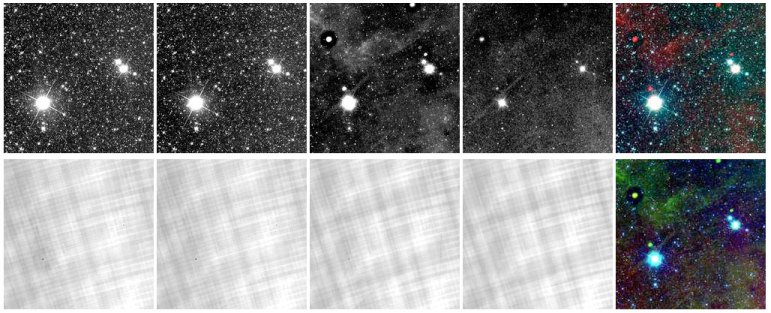 |
| Figure 1 - Atlas image 1034m485_ab41. Latents
from bright stars coadd
constructively for framesets in which the star is observed in the same scan
direction because its latent sources fall at or very near the same
point on the sky (unless the star is near the ecliptic poles). In this
example, the two bright stars near the center of the image create a
trail of latents extending up and slightly to the left. |
Latents: Two-epoch latents
 |
| Figure 2 - Atlas image 0305p075_ab41. Latents
from bright stars coadd
constructively for framesets in which the star is observed in the same scan
direction because its latent sources fall at or very near the same
point on the sky (unless the star is near the ecliptic poles). In this
example, an extremely bright star with WISE data spanning epochs six months apart leaves a trail of W3- and W4-bright
latents on opposite sides of the star. At one epoch the star was observed in north-going scans, and at another
epoch it was observed in south-going scans. |
Latents: Monster latents
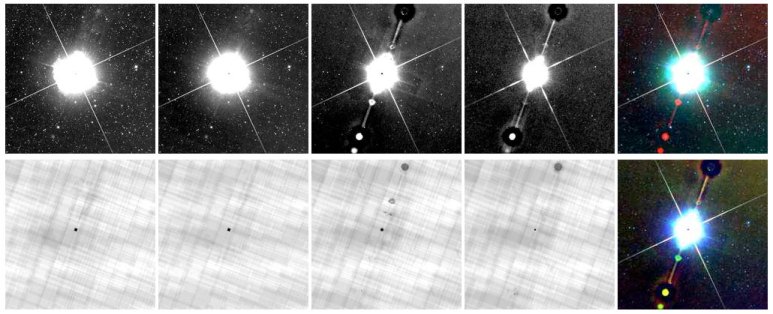 |
| Figure 3 - Atlas image 0347m031_ab41. Latents
from bright stars coadd
constructively for framesets in which the star is observed in the same scan
direction because its latent sources fall at or very near the same
point on the sky (unless the star is near the ecliptic poles). In this
example, the extremely bright star omicron Ceti (Mira) leaves a trail of W3- and W4-bright
latents, ghost images, and latents from the ghosts themselves. |
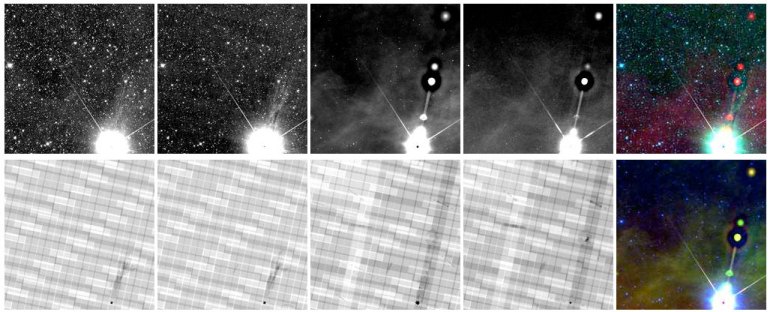 |
| Figure 4 - Atlas image 0587p121_ab41. Latents
from bright stars coadd
constructively for framesets in which the star is observed in the same scan
direction because its latent sources fall at or very near the same
point on the sky (unless the star is near the ecliptic poles). In this
example a trail of decaying latents is seen running from the bright star
toward the upper right corner of the image.
|
Latents: Smeared latents from twist near the ecliptic poles
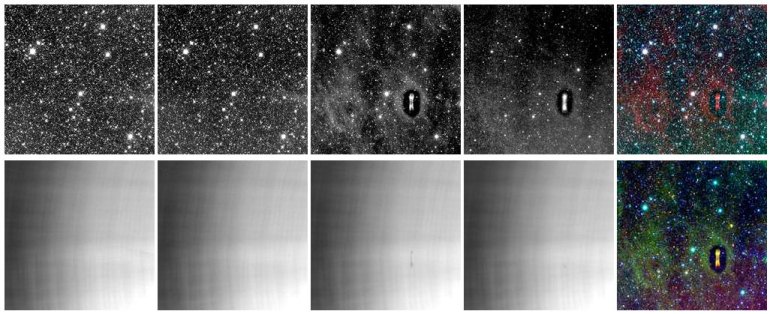 |
| Figure 5 - Atlas image 1002m667_ab41. Latents
from bright stars coadd
constructively for framesets in which the star is observed in the same scan
direction because its latent sources fall at or very near the same
point on the sky (unless the star is near the ecliptic poles, as in this example).
Here, a bright star off the right side of the image leaves
a W3/W4 latent that is elongated in the final coadds. Because the change in scan
angle from earliest to latest frame is still small, outlier rejection
during the coaddition process does not completely remove the latent
signature. |
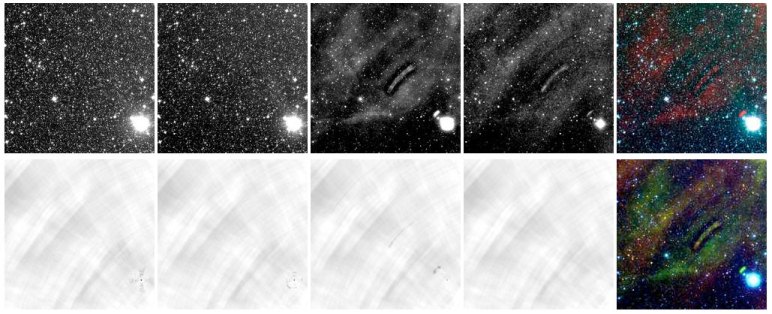 |
| Figure 6 - Atlas image 0943m652_ab41. Latents
from bright stars coadd
constructively for framesets in which the star is observed in the same scan
direction because its latent sources fall at or very near the same
point on the sky (unless the star is near the ecliptic poles, as in this example).
Here, the bright star in the lower right corner leaves
a W3/W4 ghost and latent that are arc-shaped in the final coadds. Because the change in scan
angle between consecutive frames is small, outlier rejection
during the coaddition process does not completely remove the latent
signature. |
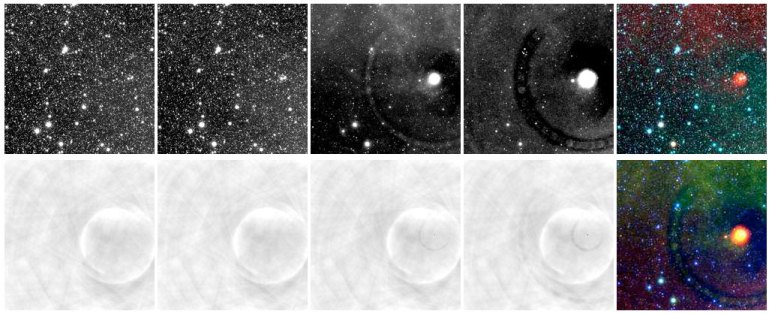 |
| Figure 7 - Atlas image 2709p666_ab41. Latents
from bright stars coadd
constructively for framesets in which the star is observed in the same scan
direction because its latent sources fall at or very near the same
point on the sky (unless the star is near the ecliptic poles, as in this example).
Here, the bright planetary known as the Cat's Eye Nebula (NGC 6543), which is located less than 0.2 deg from the
north ecliptic pole, is seen at the right side of the image. The W3/W4-bright nebula leaves
a sweeping W3/W4 artifact that forms a semi-circle in the final coadds. Outlier rejection
during the coaddition process has removed the brightest parts of the latent signature, but the low-level structure is not completely removed and results in the large
arc seen here. |
Latents: Smeared latents from moving objects
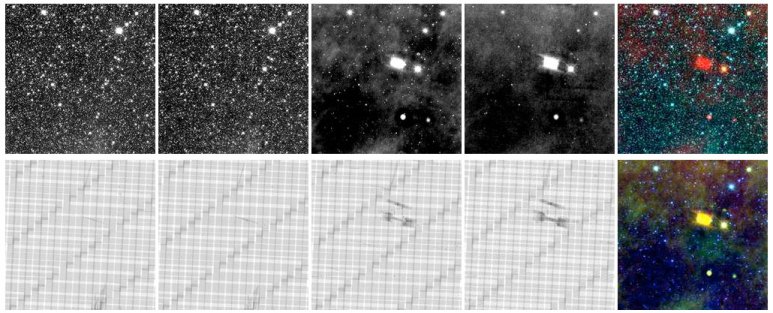 |
| Figure 8 - Atlas image 0832p196_ab41. Bright asteroids can also leave latents. If the asteroid is moving
slowly enough, outlier rejection during the coaddition process will not completely remove the latent signature,
leaving a smudgy artifact. In this example, the asteroid (seen near the center of the image as the W3/W4-bright object)
leaves a slightly extended latent artifact near the lower edge of the coadd. |
Other bright star effects: Reflection artifacts
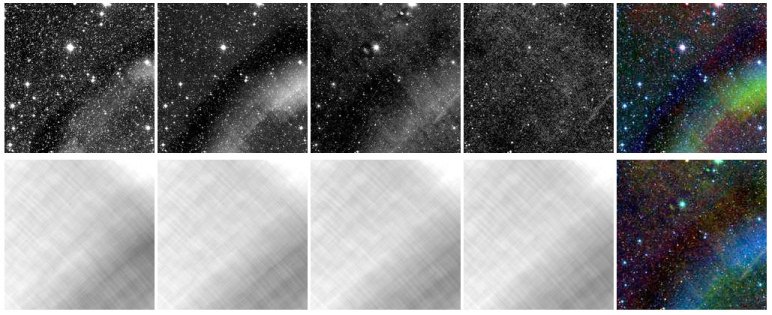 |
| Figure 9 - Atlas image 0720m606_ab41. The diffuse glow across this image
is caused by constructive coaddition of "half-frame" glows
from the bright star R Doradus, just off the field.
|
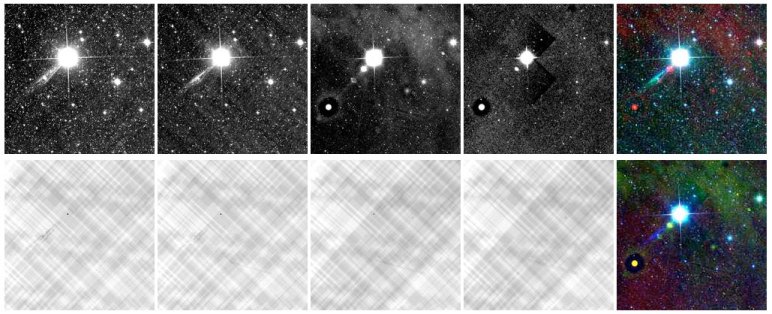 |
| Figure 10 - Atlas image 0408m546_ab41. The bright star in this image
produces a glint artifact
trailing off to the lower left in the final coadd.
|
Electronic artifacts: Diagonal striping pattern
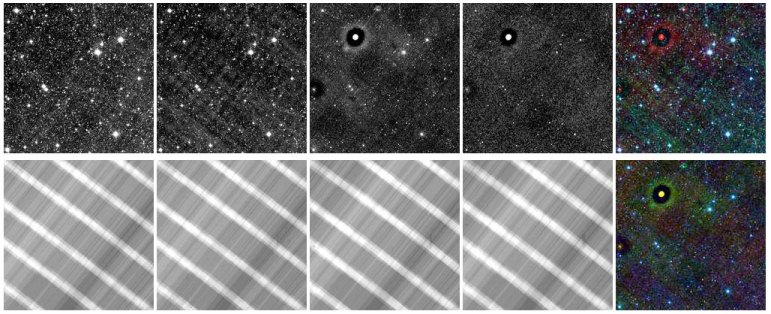 |
| Figure 11 - Atlas image 0000m576_ab41. Electronic noise can sometimes coadd constructively to produce effects such as the faint banding pattern seen here at W2. |
Features: Features are caused by real, astrophysical objects or poor coverage and may look like anomalies.
Low coverage: Holes in the images
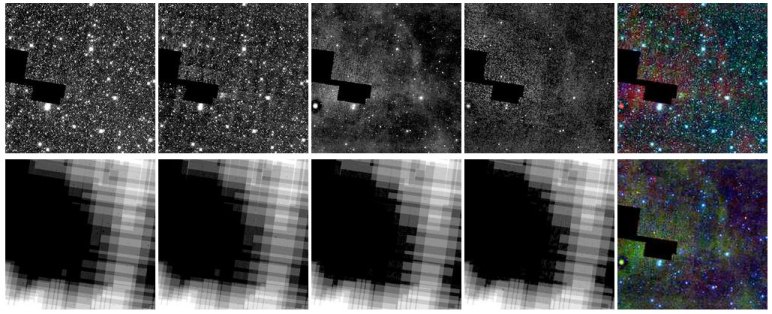 |
| Figure 12 - Atlas image 0753p696_ab41. Some areas of sky
are not covered by any high-quality frames. In this example, the areas shown in black in all four bands are areas
lacking data of sufficient quality. In areas such as these, users are encouraged to check the single-exposure frames for
lower quality data if coverage is needed.
|
Low coverage: Frame-level NaNs
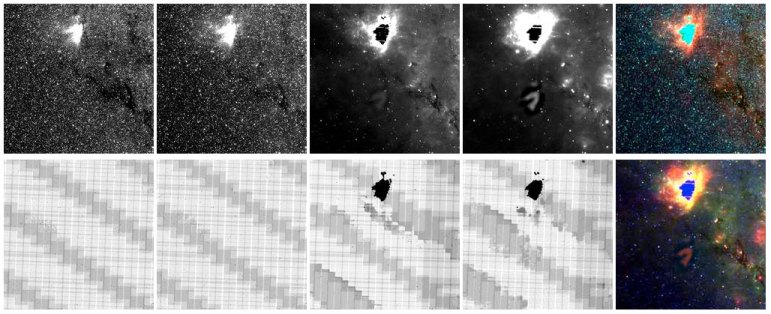 |
| Figure 13 - Atlas image 2751m167_ab41. When frames lack data due to NaNs ("Not-a-Number" values), the resulting
coadds will also contain holes. In this example, the bright nebula M17 (the Swan Nebula, aka the Omega Nebula) has saturated the individual frames, so parts of
the coadd lack any valid data. |
Low coverage: "Tiger-claw scratches" caused by planet diffraction spikes
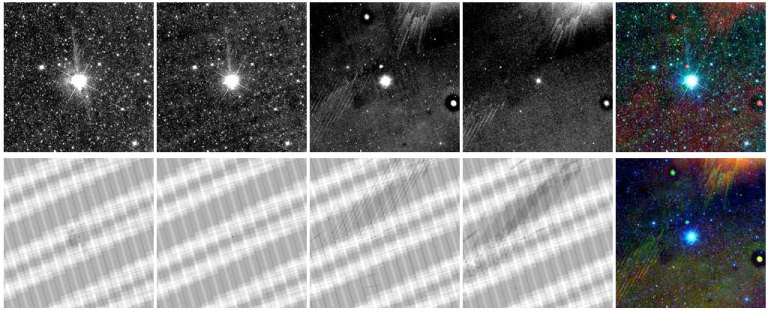 |
| Figure 14 - Atlas image 1348p181_ab41. Outlier rejection is unable to
remove single-frame anomalies if they are not significantly deviant from the values of surrounding pixels.
In the example shown here, diffraction spikes from Mars, which marched slowly
across the top of the field as the WISE data were taken, were imprinted into the W3 and W4 images as a series of parallel streaks.
(For an explanation of the non-uniform backgrounds in W3 and W4, see Figure 15.) |
Odd patterns: Variable cirrus, changing zodiacal backgrounds, and scattered Moonlight
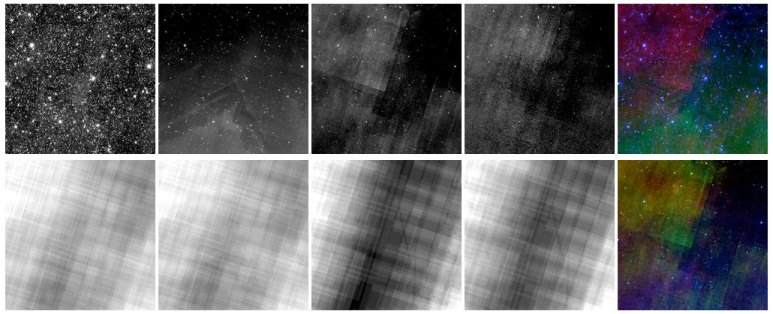 |
| Figure 15 - Atlas image 0423m016_ab41. Changes in the W3/W4
backgrounds can be caused by a number of factors including
varying zodiacal light, infrared cirrus, or scattered light from the
Moon. As with the example shown here, such changes can imprint frame
edges into the coadds, particularly when coverage is low. |
Odd patterns: Bleed-through of satellite trails
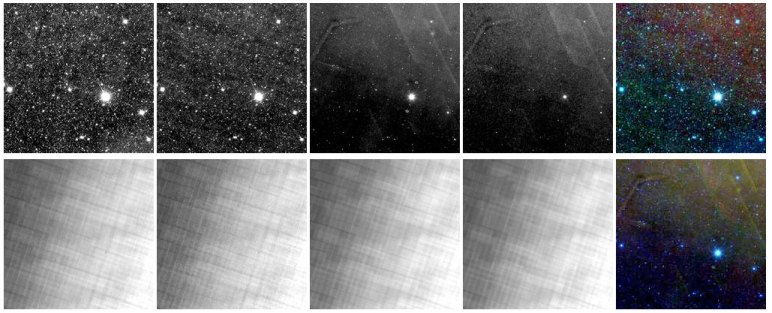 |
| Figure 16 - Atlas image 0512m197_ab41. Fainter, one-frame-only events such as the passage of a satellite during
scan mirror fly-back will not trigger outlier rejection during the
coadd generation step. In such cases, as with the latent from a kinked satellite trail seen in W3 and W4 at upper left, these
one-time-only events may imprint into the Atlas images. |
Odd patterns: Doughnut-shaped artifact left by space debris
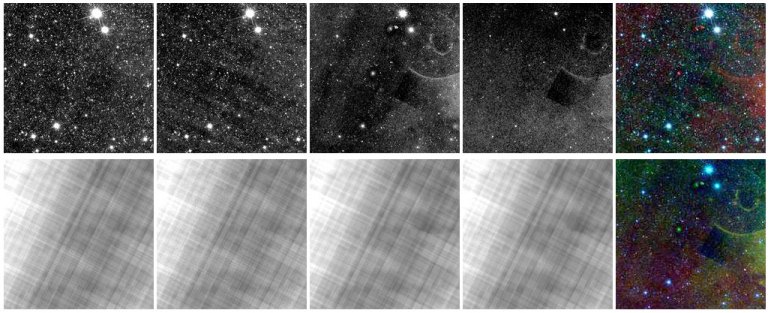 |
| Figure 17 - Atlas image 0429m364_ab41. Other one-frame-only events such as the passage of an out-of-focus piece of space debris in the field of view
will trigger outlier rejection during the
coadd generation step but only in areas with sufficiently high flux. During quality assurance most frames with out-of-focus debris were given a zero score
so they would not be used in coadd generation; however, in the
case shown here, a bad frame was not correctly flagged and an imprint appears. Although outlier rejection corrected removed the brighter part of the
doughnut-shaped feature at upper right, the outer edge (the long arc) and the edge of the inner hole (the semi-circular feature) of the doughnut remain. |
Slowly moving sources: "Blob" caused by planet
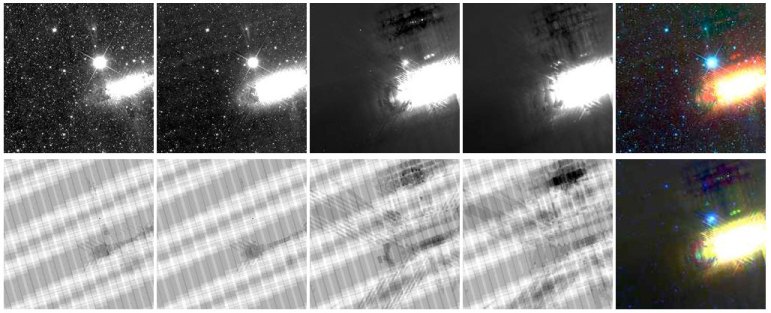 |
| Figure 18 - Atlas image 1344p196_ab41. Slowly moving sources will not be fully removed during the outlier
rejection step of coadd generation. In this example, the planet Mars is smeared across the
right side of the image. |
Slowly moving sources: "Blob" caused by comet
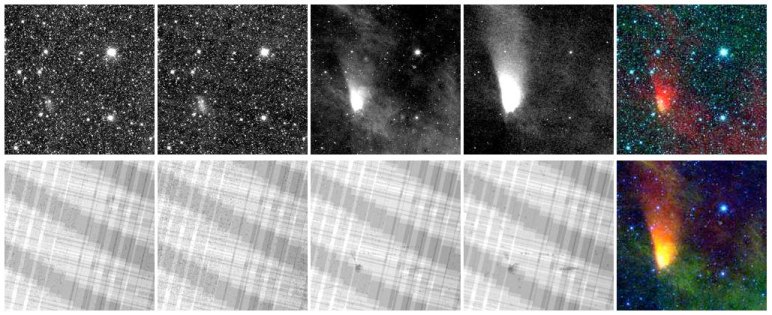 |
| Figure 19 - Atlas image 3043m303_ab41. Slowly moving sources may not be properly removed during the outlier
rejection step of coadd generation. In this example, comet 164P/Christensen creates a smear
along the left side of the image. |
Slowly moving sources: Streaks caused by asteroid
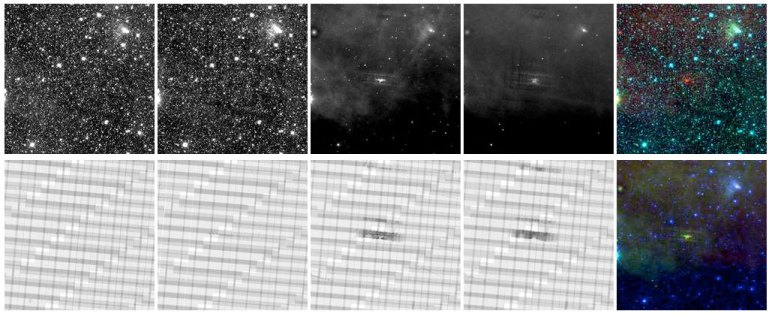 |
| Figure 20 - Atlas image 0774p212_ab41. Slowly moving sources may not be properly removed during the outlier
rejection step of coadd generation. In this example, asteroid 19 Fortuna and its associated ghosts are imprinted onto the coadds as
parallel streaks. |
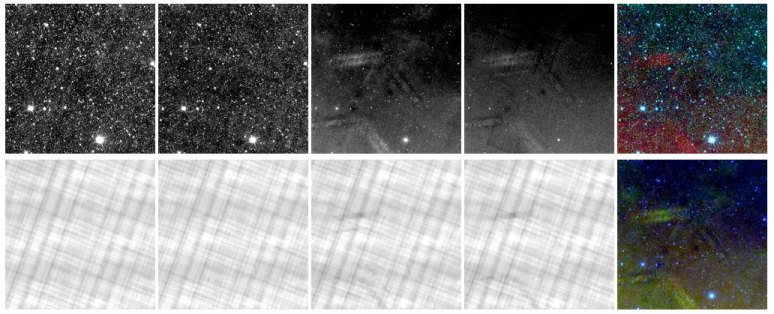 |
| Figure 21 - Atlas image 0318p045_ab41. Slowly moving sources may not be properly removed during the outlier
rejection step of coadd generation. In this example, two asteroid trails and their associated latent trails are imprinted onto the coadds. |
Real sources: Comet debris trails
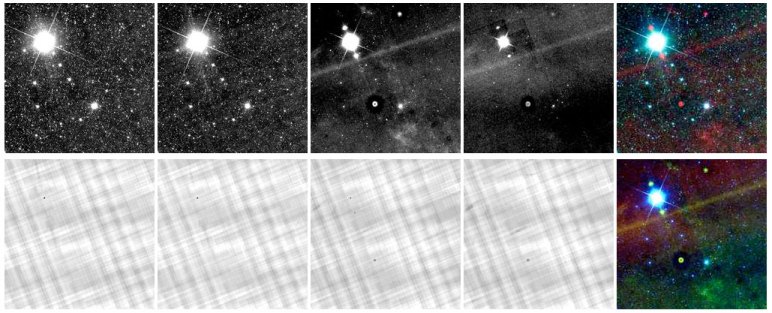 |
| Figure 22 - Atlas image 2028m076_ab41. Comet debris trails will also be seen
in the images since these appear in single-exposure images. These may smear out slightly in the Atlas images because of
parallax: WISE's Earth-based vantage point changes slightly from frame to frame because these objects are very nearby. (The
bright star also leaves two-epoch latents as described in
Figure 2.)
|
Real sources: Bubbles and shells
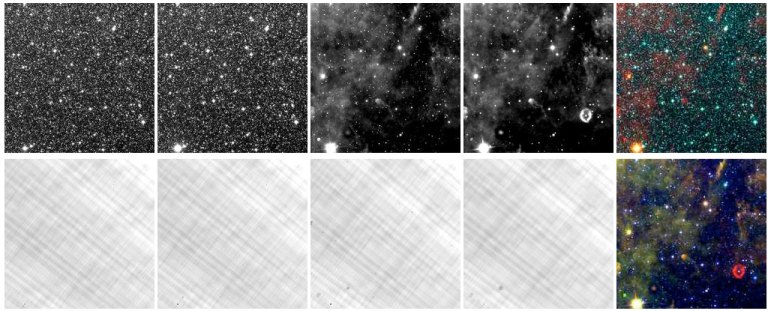 |
| Figure 23 - Atlas image 1677m652_ab41. Bubbles and shells seen
in the single-exposure frames will, of course, also appear in the Atlas images and may mimic an artifact. In
this example a W4-bright shell around the Wolf-Rayet star WR40 is seen. |
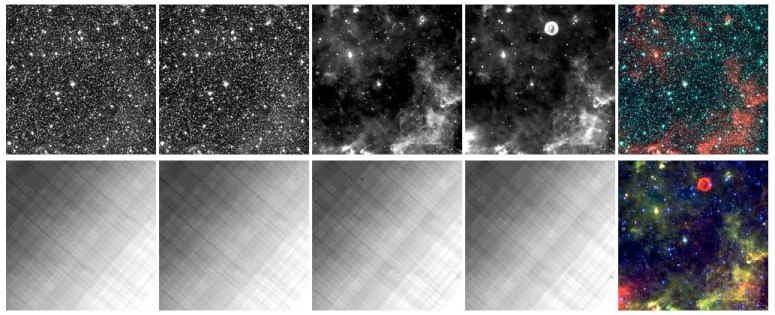 |
| Figure 24 - Atlas image 0066p636_ab41. Bubbles and shells seen
in the single-exposure frames will, of course, also appear in the Atlas images and may mimic an artifact. In
this example the W4-bright Tyhco supernova remnant is seen. |
Last update: 2012 January 31





























